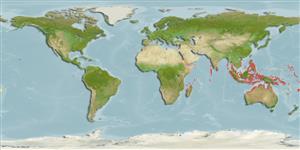>
Ovalentaria/misc (Various families in series Ovalentaria) >
Pomacentridae (Damselfishes) > Pomacentrinae
Etymology: Neopomacentrus: Greek, neos = new + Greek,poma = cover, operculum + Greek,kentron = sting (Ref. 45335).
More on author: Bleeker.
Environment: milieu / climate zone / depth range / distribution range
Ökologie
seewasser; süßwasser; brackwasser demersal; tiefenbereich 0 - 3 m (Ref. 7247). Tropical; 23°C - 28°C (Ref. 12468); 19°N - 21°S
Indo-West Pacific: East Africa to Indonesia and the Solomon Islands, north to the Philippines, south to northern Australia and Vanuatu. Reported from Taiwan (Ref. 5193).
Size / Gewicht / Alter
Maturity: Lm ? range ? - ? cm
Max length : 10.0 cm TL Männchen/unbestimmt; (Ref. 48636)
Rückenflossenstacheln (insgesamt): 13; Rückenflossenweichstrahlen (insgesamt): 11-12; Afterflossenstacheln 2; Afterflossenweichstrahlen: 11 - 12.
Adults inhabit mangroves, estuaries, lower reaches of freshwater streams, and harbors with freshwater discharge. Also found in pure fresh water, but always within a few kilometers of the sea (Ref. 2847). They occur in brackish waters of coastal embayments and mangrove estuaries (Ref. 44894). Spawning may take place in both brackish and fresh waters (Ref. 2847). Oviparous, distinct pairing during breeding (Ref. 205). Eggs are demersal and adhere to the substrate (Ref. 205). Males guard and aerate the eggs (Ref. 205). Diurnal species (Ref. 52881).
Life cycle and mating behavior
Geschlechtsreife | Fortpflanzung | Ablaichen | Eier | Fecundity | Larven
Oviparous, distinct pairing during breeding (Ref. 205). Eggs are demersal and adhere to the substrate (Ref. 205). Males guard and aerate the eggs (Ref. 205).
Allen, G.R., 1991. Damselfishes of the world. Mergus Publishers, Melle, Germany. 271 p. (Ref. 7247)
IUCN Rote Liste Status (Ref. 130435)
Bedrohung für Menschen
Harmless
Nutzung durch Menschen
Fischereien: weniger kommerziell
Mehr Information
ReferenzenAquakulturAquakultur ProfilZuchtlinienGenetikElectrophoresesVererbbarkeitKrankheitenVerarbeitungNutrientsMass conversion
Tools
Zusatzinformationen
Download XML
Internet Quellen
Estimates based on models
Preferred temperature (Ref.
123201): 26.8 - 29.3, mean 28.7 °C (based on 2180 cells).
Phylogenetic diversity index (Ref.
82804): PD
50 = 0.5000 [Uniqueness, from 0.5 = low to 2.0 = high].
Bayesian length-weight: a=0.01479 (0.00642 - 0.03409), b=3.00 (2.80 - 3.20), in cm total length, based on LWR estimates for this (Sub)family-body shape (Ref.
93245).
Trophic level (Ref.
69278): 3.4 ±0.45 se; based on food items.
Widerstandsfähigkeit (Ref.
120179): hoch, Verdopplung der Population dauert weniger als 15 Monate. (Preliminary K or Fecundity.).
Fishing Vulnerability (Ref.
59153): Low vulnerability (10 of 100).
Nutrients (Ref.
124155): Calcium = 364 [206, 917] mg/100g; Iron = 1.72 [1.04, 3.06] mg/100g; Protein = 18.3 [17.3, 19.3] %; Omega3 = 0.225 [0.113, 0.453] g/100g; Selenium = 19.5 [9.3, 44.0] μg/100g; VitaminA = 63.1 [22.5, 175.6] μg/100g; Zinc = 2.16 [1.43, 3.28] mg/100g (wet weight);
